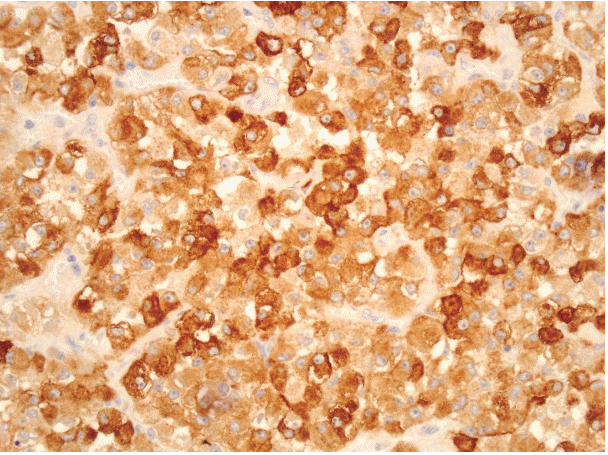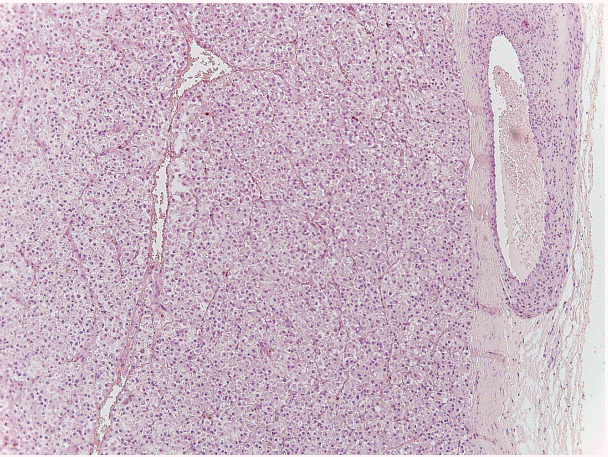Articles
- Page Path
- HOME > J Pathol Transl Med > Volume 51(1); 2017 > Article
-
Letter to the Editor
Perivascular Epithelioid Cell Tumors (PEComas) of the Orbit - Panagiotis Paliogiannis,, Giuseppe Palmieri1, Francesco Tanda, Antonio Cossu
-
Journal of Pathology and Translational Medicine 2017;51(1):7-8.
DOI: https://doi.org/10.4132/jptm.2016.10.26
Published online: January 5, 2017
Department of Surgical, Microsurgical and Medical Sciences, University of Sassari, Sassari, Italy
1Institute of Biomolecular Chemistry, Cancer Genetics Unit, C.N.R., Sassari, Italy
- Corresponding Author: Panagiotis Paliogiannis, MD, PhD Department of Surgical, Microsurgical and Medical Sciences, University of Sassari, Viale San Pietro 43, 07100, Sassari, Italy Tel: +39079228596, Fax: +39-0079228596, E-mail: panospaliogiannis@gmail.com
• Received: September 29, 2016 • Revised: October 21, 2016 • Accepted: October 26, 2016
© 2017 The Korean Society of Pathologists/The Korean Society for Cytopathology
This is an Open Access article distributed under the terms of the Creative Commons Attribution Non-Commercial License (http://creativecommons.org/licenses/by-nc/3.0/) which permits unrestricted noncommercial use, distribution, and reproduction in any medium, provided the original work is properly cited.
Fig. 1.A section of the lesion stained with hematoxylin and eosin, evidencing its microscopic features and perivascular origin.


- 1. Kim HY, Choi JH, Lee HS, Choi YJ, Kim A, Kim HK. Sclerosing perivascular epithelioid cell tumor of the lung: a case report with cytologic findings. J Pathol Transl Med 2016; 50: 238-42. ArticlePubMedPMCPDF
- 2. Cossu A, Paliogiannis P, Tanda F, Dessole S, Palmieri G, Capobianco G. Uterine perivascular epithelioid cell neoplasms (PEComas): report of two cases and literature review. Eur J Gynaecol Oncol 2014; 35: 309-12. PubMed
- 3. Goto H, Usui Y, Nagao T. Perivascular epithelioid cell tumor arising from ciliary body treated by local resection. Ocul Oncol Pathol 2015; 1: 88-92. ArticlePubMedPDF
- 4. Iyengar P, Deangelis DD, Greenberg M, Taylor G. Perivascular epithelioid cell tumor of the orbit: a case report and review of the literature. Pediatr Dev Pathol 2005; 8: 98-104. ArticlePubMedPDF
- 5. Guthoff R, Guthoff T, Mueller-Hermelink HK, Sold-Darseff J, Geissinger E. Perivascular epithelioid cell tumor of the orbit. Arch Ophthalmol 2008; 126: 1009-11. ArticlePubMed
REFERENCES
Figure & Data
References
Citations
Citations to this article as recorded by 

- Pigmented perivascular epithelioid cell tumors of the orbit with NONO::TFE3 fusion: Molecular evaluation and literature review
Naoko Takeda-Miyata, Ken-ichi Yoshida, Miho Shirono, Akihide Watanabe, Yoji Kukita, Chie Sotozono, Eiichi Konishi
American Journal of Ophthalmology Case Reports.2025; 39: 102378. CrossRef - Perivascular epithelioid cell tumor of the lacrimal gland
Wenqin Xu, Rui Ma, Yueyue Li, Zhicha Hu, Guolu Zhang, Jian Hu, Yan Hei, Xinji Yang
Orbit.2024; 43(3): 362. CrossRef - An orbital perivascular epithelioid cell tumor (PEComa) in a 9-year-old boy: Case report and review of the literature
N. Bouzid, M. Bugada, D. Pissaloux, C. Burillon, F. Tirode, J. Barbier, A. de la Fouchardière, G. Kielwasser
Journal Français d'Ophtalmologie.2024; 47(7): 104215. CrossRef - Ocular PEComas are frequently melanotic and TFE3-translocated: report of two cases including the first description of PRCC-TFE3 fusion in PEComa
Y. Gao, G. Chen, C. Chow, I. Io, E. W. N. Wong, W. M. S. Tsui, W. Y. Lam, K. F. To, J. K. C. Chan, Wah Cheuk
Virchows Archiv.2021; 478(5): 1025. CrossRef - Orbital TFE3-Rearranged Perivascular Epithelioid Cell Tumor: A Case Report and Review of the Literature
Silvia Feu-Basilio, Jessica Matas, Marina Dotti-Boada, Agustin Toll, Ana-Belen Larque, Ramon Pigem, Santiago Ortiz-Perez
The American Journal of Dermatopathology.2021; 43(12): e263. CrossRef - Perivascular epithelioid cell tumor (PEComa) of the pterygopalatine fossa
Michael I. Dougherty, Spencer C. Payne, Akriti Gupta, Jose L. Mattos
Clinical Case Reports.2020; 8(3): 553. CrossRef - Giant Perivascular Epithelioid Cell Tumor of the Orbit: A Clinicopathological Analysis and Review of the Literature
Akshay G. Nair, Swaranjali S. Gore, Amol Y. Ganvir, Namrata G. Adulkar, Indumati Gopinathan, Anuradha K. Murthy, Nayana A. Potdar, Chhaya A. Shinde
Ocular Oncology and Pathology.2018; 4(5): 272. CrossRef
 PubReader
PubReader ePub Link
ePub Link-
 Cite this Article
Cite this Article
- Cite this Article
-
- Close
- Download Citation
- Close
- Figure
Perivascular Epithelioid Cell Tumors (PEComas) of the Orbit


Fig. 1. A section of the lesion stained with hematoxylin and eosin, evidencing its microscopic features and perivascular origin.
Fig. 2. Human melanoma black 45 immunostaining of the tumor.
Fig. 1.
Fig. 2.
Perivascular Epithelioid Cell Tumors (PEComas) of the Orbit

 E-submission
E-submission





